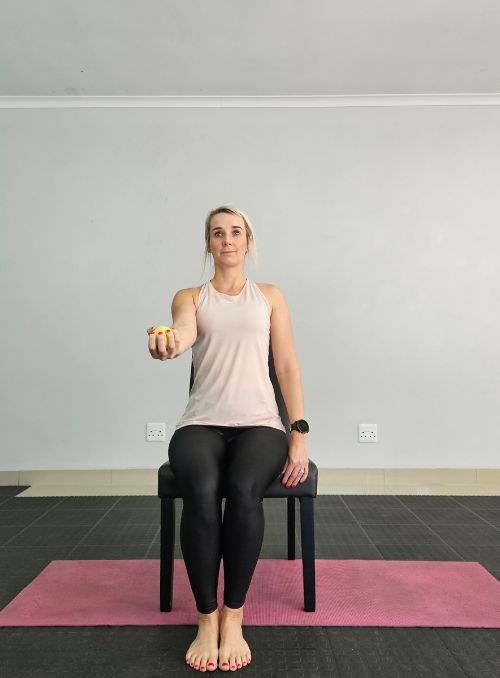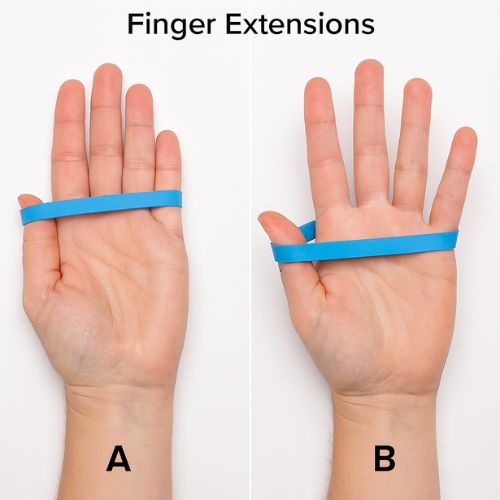The wrist is a complex joint that includes numerous small bones, muscles, ligaments, and tendons, which can be supported and then protected through wrist strengthening [4] exercises.
If you’re looking for simple yet effective wrist strengthening exercises, you’re in the right place.
These exercises are specifically designed to improve wrist mobility, enhance grip strength, and support overall joint health.
Let’s jump right into the step-by-step guide to build stronger, more flexible wrists.
1. Wrist Flexion Stretch

Starting Position: Sit comfortably at a table with one arm extended in front of you, palm facing up.
- Use the opposite hand to pull back your fingers toward your body gently.
- Keep your elbow straight and then your shoulder relaxed.
- Hold this gentle stretch for 20–30 seconds.
- Repeat 3 times per hand.
Target: Wrist flexors
2. Wrist Extension Stretch

Starting Position: Extend your arm with palm facing down.
- With the other hand, pull the fingers downward and toward your body.
- After that, you should feel a stretch on the top of your forearm.
- Hold for 20–30 seconds and then repeat 3 times.
Target: Wrist extensors
3. Wrist Curls with Light Dumbbell

Starting Position: Sit with your forearm resting on a table or bench, palm facing up, holding a light dumbbell or water bottle.
- Let your hand hang slightly off the edge.
- After that, as part of your wrist strengthening exercises, curl your wrist up, hold briefly, then slowly lower it down.
- Perform 10–15 reps per arm.
- Do 2–3 sets.
Target: Wrist flexors
4. Reverse Wrist Curls

Starting Position: Same as wrist curls, but palm facing down, as part of wrist strengthening exercises.
- Basically, lift the dumbbell using your wrist only.
- Control the downward motion slowly.
- Perform 10–15 reps, 2–3 sets per side.
Target: Wrist extensors
5. Wrist Rotations

Starting Position: Sit with elbow bent at a right angle, hand held out in front.
- With your fingers pointed forward, slowly rotate your wrist clockwise and then counter-clockwise.
- Perform 10 rotations in each direction.
- This helps maintain wrist mobility and then promotes healthy joint function.
Target: Full wrist range
6. Tennis Ball Squeezes

Starting Position: Sit or stand in a neutral position.
- Hold a tennis ball in one hand and then squeeze it as hard as comfortably.
- Hold for 5 seconds, then release.
- Do 10–15 squeezes per hand, 2–3 sets.
Target: Grip strength
7. Rubber Band Finger Extensions

Starting Position: Wrap a rubber band around all five fingers.
- Slowly open your hand against the resistance of the band.
- After that, return to the start without letting the band snap.
- Do 15 reps, 2 sets per hand.
Target: Finger extensors
8. Prayer Stretch

Starting Position: Sit or stand with palms pressed together in front of your chest.
- Lower your hands toward your waist, keeping palms touching.
- Hold the stretch for 20–30 seconds.
- After that, repeat 2–3 times.
Target: Wrist flexors and extensors
“Your wrists are small joints that do a big job — from fine motor control to bearing weight. Just like your core or legs, your wrists need to be trained for strength and flexibility. Neglecting them can contribute to overuse injuries like tendonitis and may increase the risk of conditions such as carpal tunnel syndrome, especially in people who type all day or lift weights improperly.”-Dr. Nicholas DiNubile, MD— Orthopedic Surgeon & Sports Medicine Specialist
Other Tips for Wrist Pain Relief
If you’re already experiencing discomfort, consider these self-care strategies to complement your exercise program:
The most common areas where osteoporotic fracture happens [2] are the wrists, hips, and spine. However, it can also occur in other areas, such as the arm or pelvis.
- Warm up your wrists before starting any upper arm or grip activity.
- Position your keyboard and mouse so your wrists remain in a neutral, straight alignment, avoiding excessive upward or downward bending.
- Rest your wrists if pain increases, and apply cold to reduce inflammation.
- Improve your posture [5] to reduce strain on wrist joints — keep your shoulders relaxed and then elbows bent at approximately 90°.
- Use wrist braces temporarily for support if recommended by your physical therapist.
Regular physical activity [3] like osteoporosis wrist exercises can help in protecting bones.
Here are some of the benefits of exercising:
- Increase muscle strength
- Improve balance
- Decrease the risk of bone fracture
- Maintain or improve posture
- Decrease pain
- Increased mobility or range of motion
- Bone loss reduction
When to Seek Help From a Wrist Specialist
Wrist pain that doesn’t improve with strengthening exercises and then stretching could indicate a more serious issue.
You should see a wrist specialist or physical therapist if:
- Pain lasts more than a few weeks despite treatment.
- You experience numbness, tingling, or weakness (signs of carpal tunnel syndrome).
- The wrist area appears swollen or visibly deformed.
- In addition, there’s a significant loss of wrist range or motion.
- Pain affects your ability to perform everyday tasks.
- Prompt attention can prevent long-term damage and then help you return to your regular activities safely.
Final Thoughts
Building strong wrists takes consistency and then attention to proper form.
These wrist exercises will help you strengthen muscles, improve mobility, and then support your body through everything from daily chores to intense workouts.
Osteoporosis is a medical condition [1] that is characterized by weak thinning of bones. Bone loss that comes with this is often unseen unless a sudden break of bones or “fracture” happens – thus calling it – The Silent Disease.
Remember: always start slowly, use lightweight, and listen to your body. If in doubt, consult a physical therapist to tailor an exercise program just for you.
Boost your bone health in just 14 days! Download the 14-Day Bone Strengthening Quick Start Program now and start building stronger, healthier bones from the comfort of your home.
Frequently Asked Questions
How often should I do wrist strengthening exercises?
You can perform most wrist exercises 3–5 times per week. Start slowly with 1–2 sets and then gradually increase. listen to your body and allow recovery time if soreness or fatigue occurs.
Can wrist exercises help with carpal tunnel syndrome?
Gentle wrist mobility and nerve-gliding exercises may ease early carpal tunnel symptoms, but they’re not a substitute for medical care. Consult a specialist if symptoms continue or worsen.
Is it normal to feel sore after wrist workouts?
Mild soreness is normal, especially if you’re new to these movements. However, sharp pain, numbness, or swelling could indicate injury or overuse. Rest, apply ice, and then consult a physical therapist if needed.


